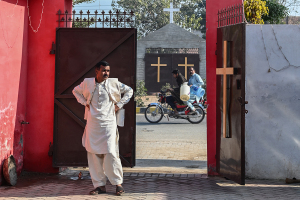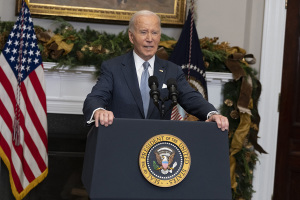Trauma Grips Survivors of Church Blast in Alexandria, Egypt
ALEXANDRIA, Egypt - The last thing Osni Naim Michael remembers seeing on New Year's Eve was more than a dozen people standing in front of him who instantly disintegrated in a brilliant flash of light.
In the split second that followed, the shock wave of the bomb threw the 57-year-old Michael to the ground. As he lay there – bleeding, blind, deaf and unable to get up – he could feel people hurrying over him, fleeing the blast site. His daughter eventually found him, pulled him from the scene and took him to the hospital.
Several days after the attack, while recovering from injuries, Michael learned that the place he was standing when the bomb detonated marked a macabre line of demarcation; everyone between him and the bomb is now dead, and almost everyone behind him lived.
"I remember the flash and everything exploding around me," Michael said. "The 18 people were between me and the bomb … the 18 were killed, and I was only wounded. I thank Jesus Christ for this."
In the early-morning hours of Jan. 1, after a New Year's Eve Mass celebration in Alexandria, Egypt, a suicide bomber blew himself up at the Coptic Orthodox church of St. Mark and Pope Peter, or "(Two) Saints Church," according to the Egyptian government. At least 22 people died in the blast or later as a result of their injuries; the remains from one or two others are still unidentified and unclaimed. Another 97 people were reportedly injured from the explosion, which witnesses initially said came from a car-bomb; area Christians suspect more than one assailant.
The latest victim to succumb to his injuries was Samuel Girgis. In his 30s, Girgis died on Jan. 21 in a London hospital after an infection from the burns that covered more than half his body, according to doctors from St. Mark's Hospital in Alexandria. He was married and had an infant child.
The explosion left the church smeared with blood, and it shattered windows throughout the building. The damage to the structure is largely repaired or cleaned, but now the people who make up the church are left to struggle with injuries, unanswered questions and their faith.
Wounds Seen and Unseen
Michael was one of more than 70 patients who were treated at St. Mark's Hospital for various injuries sustained during the bombing. The tall, burly Michael was largely unscathed by the explosion with one major exception – the shockwave from the blast shattered his left eye and severely damaged the other. The left eye had to be removed, and the right eye is essentially useless. His eardrums were damaged in the explosion but have almost healed.
For weeks, Michael needed constant care. His family members took turns staying with him in his hospital room – his wife during the day, and his son sleeping in a bed next to his at night. Doctors said he will probably never see again. But Michael, a manager at a petroleum factory, holds on to hope that he will see one day, either through medical or divine intervention.
On Saturday (Jan. 29), while the rest of his country was locked in political riots, Michael was placed on a plane with five others to Germany for medical treatment. Although his treatment options are now better, his prognosis is still uncertain.
"I am sure that Jesus Christ will not leave me," he said in the days before he was transported.
St. Mark's Hospital, a facility adjacent to and run by the Saints church, was overwhelmed after the bombing, according to Dr. Mena Michael, a cardiologist at the hospital. Police closed the bombing site and the hospital for several hours after the attack, and when the doors reopened, the hospital was deluged with people suffering burns, lacerations and crushed or missing limbs; they were full of fragments that the terrorists packed into the explosive device.
Doctors still have a large envelope full of bolts and bits of wire, which they call "foreign objects" that they removed from the wounded.
Possibly the hardest thing doctors had to face was documenting and processing the bodies of friends and colleagues who worked at the hospital. One doctor who ran the laboratory at St. Mark's was killed with her two daughters and sister. Her husband returned to the front of the church after retrieving his car to find his entire family dead.
Michael said the whole thing was a "nightmare."
"You have two hands, you just have two hands to work in [the body of] one patient – not in two, not in three, not in four [patients]," Michael said. "Imagine about 10 at a time, 15 at a time. What can you do?"
Doctors were also tasked with correcting medical procedures that they said were done improperly at a nearby state-run hospital, such as one patient whose legs were left full of fragments. That patient was Girgis.
Promises made by state officials to pay for the medical treatment have only materialized in part, doctors said, so Christian business leaders have promised to pay for the remaining costs. Still, some victims are uncertain how they will pay for their medical treatment. In spite of how medical bills will eventually be paid, most of the seriously wounded have been moved to hospitals scattered across Europe, with the bulk being in Germany.
As the bodies of the wounded continue to heal, many are now left to deal with the unseen emotional scars. A 7-year-old girl whose face was badly burned, legs were broken and had one toe amputated lay in a bed all day next to the bed of her mother, who was also injured. Michael said the girl was having an especially hard time dealing with the emotional trauma of the attack, and doctors are worried about her.
Culprits
On Jan. 23, Egyptian Interior Minister Habib al-Adly said his ministry had conclusive evidence that a Palestinian terror group, the Army of Islam, was responsible for the church bombing. The group has publicly denied responsibility for the act, and other Palestinian groups normally in conflict or even open combat with the Army of Islam have said they don't believe the Egyptian government's accusations.
The Palestinian groups are not alone.
From the beginning, the Egyptian government asserted that the attack was carried out by a group from outside Egypt and not by Egyptians themselves. Many Coptic leaders have publically voiced their doubts about the government's declaration; they said the Jan. 23 announcement was just the latest example of the government refusing to admit that there is a problem with anti-Christian attitudes and violence within Egypt.
Asked about the culprits, all of more than two dozen members of the Saints church said they thought a group of Egyptians were responsible for the attack and not any outside group. They said they also didn't believe the attack was a suicide bombing, but rather a car bombing, based on eyewitness reports. The congregation members said the bombing was part of a larger problem of Coptic Christians being persecuted and discriminated against by an Egyptian society that is increasingly hard-line Islamic and intolerant.
"Most of us believe it is something internal, not from anywhere outside," said one woman at the church who requested anonymity. "And the government is trying to say it's from somewhere outside to show that our country is really stable and nothing is harming us from inside."
In the wake of the bombing, several Facebook sites and other Web sites sprang up in Egypt in support of the violence. The sentiment was echoed in the comments sections of the online versions of several Egyptian newspapers.
As if to add emphasis to the arguments of Coptic Christians, two days after the bombing a police officer boarded a train in southern Egypt and, upon seeing a group of Christians, shot at the group, killing one man. The police officer was later arrested. The same week, Mohamed Ahmed Hussein was sentenced to death for last year's shooting outside a church in Nag Hammadi that left six Christians and one Muslim security guard dead.
One woman visiting a victim at St. Mark's Hospital, a co-worker who is several months pregnant, said the hatred against Christians in Egypt is palpable.
"We are four out of 200 workers, and you can tell by the way they look at us now, they are happy about what happened," said the woman, who also didn't want to be indentified for security reasons.
One man, the son of a Christian whose abdomen had been ripped open in the blast, said that Egyptians are taught in school that Christians are "liars and thieves and bad people."
A New Shrine
Whatever the bombers hoped to accomplish on the night of the attack, the site has now become a shrine and a rallying cry for Egyptian Christians. Copts from the Orthodox Church and other denominations are traveling hundreds of miles to visit the church.
The visitors said the bombing has increased the faith and spiritual commitment of the Copts.
The congregation has set up several displays honoring the victims. One billboard is covered with crowns representing the "crown of life" promised in the Bible to Christians who persevere "under trial." Another display, a vinyl poster, is covered with the photographs of faces of the deceased.
Possibly the most poignant display is that of a life-size portrait of Jesus, arms outstretched, painted on a piece of plywood. After the bombing, congregants gathered the body pieces of the victims and, using the picture as a stretcher, brought them inside the church. The image of Christ, protected by glass, is smeared with the blood of those who died.
Some who came to the church stood in front of murals of the victims, posing for photographs taken with cell phone cameras. Others followed priests as they explained what happened the night of the attack. Still others wander aimlessly, dabbing tears from their eyes, or touching the faces of the photographs of the people who were killed.
A woman from St. George's church in Giza, a suburb of Cairo two hours away by train, said the bombing has forced many Copts to re-examine their faith. Before, she said, the news of attacks and unrest would lead members of the Coptic Orthodox Church to commit themselves to their faith, "But in a couple of days everything would go back to normal."
This time, it is different, she said. People are truly shaken.
"Most have come back to church, have repented and are praying to God," she said. "We can go to God any time, so each one of us should be prepared to go anytime."





























